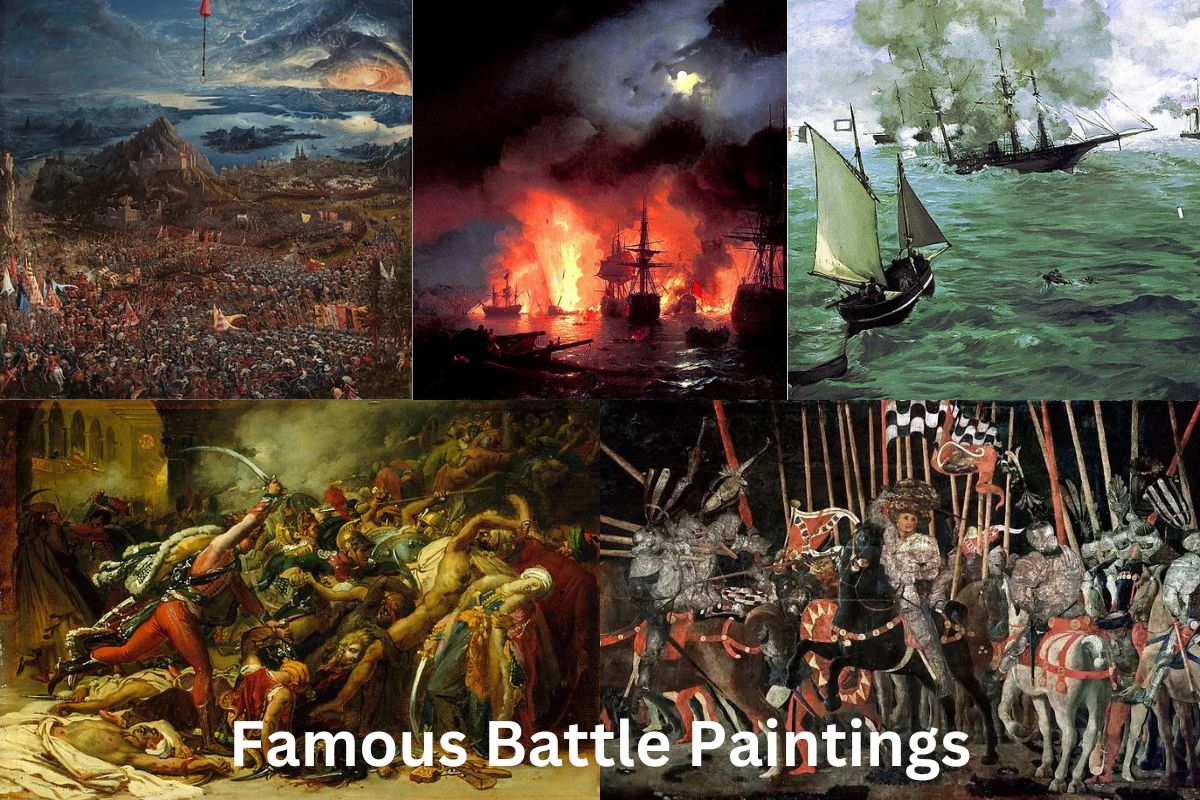Paintings of battles provide a visual picture of military conflict by demonstrating the impact of the struggle through depictions of men and women waiting, preparing, fighting, and suffering as well as celebrating.
The topics cover a wide range of facets of war, as well as the individual’s perspective on the conflict, regardless of whether they were an ally or an opponent, a service member or a civilian, military or political, social or cultural.
The spectrum of topics covered includes the origins, dynamics, and repercussions of violent conflict.
Famous Battle Paintings
1. The Battle of San Romano – Paolo Uccello
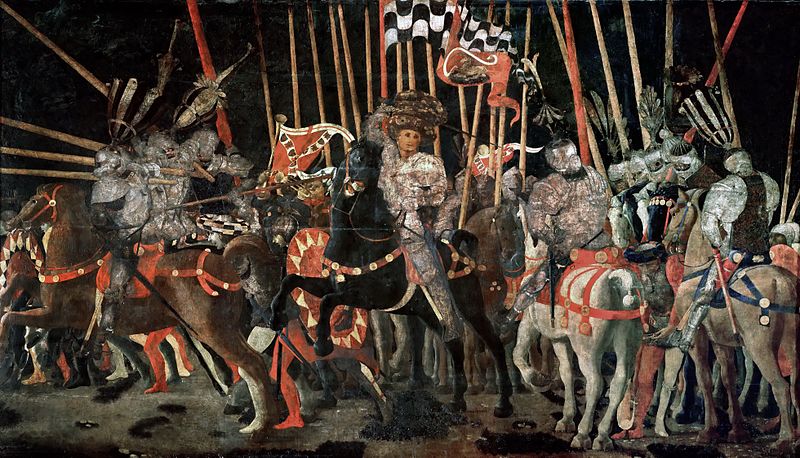
This clash between Florentine and Sienese forces was shown in a triptych by Florentine artist Paolo Uccello in 1432 and named The Battle of San Romano.
They are important because they are a rare example of a large-scale secular commission, and they show how linear perspective was applied in early Italian Renaissance art. Each of the egg tempera paintings on oak panels measures more than 3 meters in length.
Panels were commissioned by a Florentine Bartolini Salimbeni probably between 1435 and 1460, according to the National Gallery.
Paintings were so sought after in the 15th century that Lorenzo de’ Medici stole two of them and hung them in his palace.
The National Gallery in London, the Gallery of the Uffizi in Florence, and the Musée du Louvre in Paris presently all have collections that feature these paintings.
2. The Surrender of Breda – Diego Velázquez
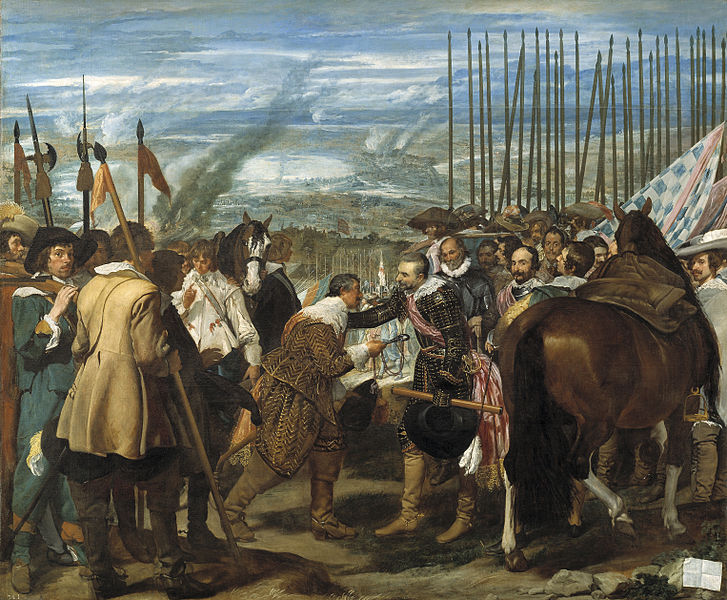
Diego Velázquez, a Spanish artist of the Golden Age, painted “La rendición de Breda” (The Surrender of Breda) in the early 17th century.
Completed between 1634 and 1635, it was influenced by Velázquez’s trip to Italy with Ambrogio Spinola, the Genoese-born Spanish general who seized Breda on June 5, 1625. A key of Breda, previously held by the Dutch, is handed over to the Spanish in this picture.
It’s widely regarded as one of Velázquez’s finest paintings. A Dutch leader, Justinus van Nassau, and a Spanish Genoese general, Spinola, are shown in Velázquez’s The Surrender of Breda.
Also Read: Famous Military Paintings
The Siege of Breda in 1624, which took place during the Eighty Years War, is shown in the film The Surrender of Breda. The modern-day Netherlands, Belgium, and Luxembourg are all part of the Seventeen Provinces, which rose up against Philip II of Spain and started the war.
The battle’s conclusion was shown by Velázquez, who also made clear which side was Spanish and which was Dutch. While representing both sides of the conflict and the inevitable exhaustion of combat in the soldiers’ looks, the picture portrays the Spanish as a formidable adversary.
3. The Revolt of Cairo – Anne-Louis Girodet de Roussy-Trioson
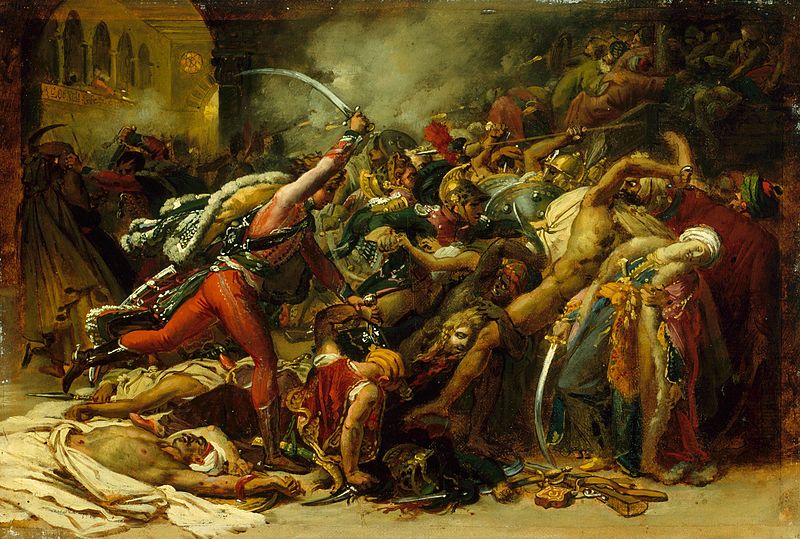
Citizens of Cairo rose up on the 21st and 22nd of October, 1798, in what became known as the Revolt of Cairo to oppose Napoleon Bonaparte’s French occupation of Egypt.
After Napoleon’s invasion of Egypt in 1798, the French capitals of Alexandria and Cairo fell within a year. The inhabitants of Cairo, however, rose up in revolt against the French in October of that year.
Upon learning that Bonaparte was in Old Cairo, the locals began arming themselves and reinforcing strategic locations, most notably the Al-Azhar Mosque.
The rioting Egyptians not only took the life of a French officer named Dominique Dupuy, but also of Bonaparte’s Aide-de-camp named Joseph Sulkowski.
Excited by the sheikhs and imams, many of the people swore by the Prophet to destroy all and any Frenchman they met, and any Frenchmen they encountered — at home or in the streets – were cruelly slaughtered.
Bonaparte was turned away from the main entrances to the city by a massive crowd, and he was eventually forced to enter through the Boulaq gate.
4. Battle of Cesme at Night – Ivan Aivazovsky
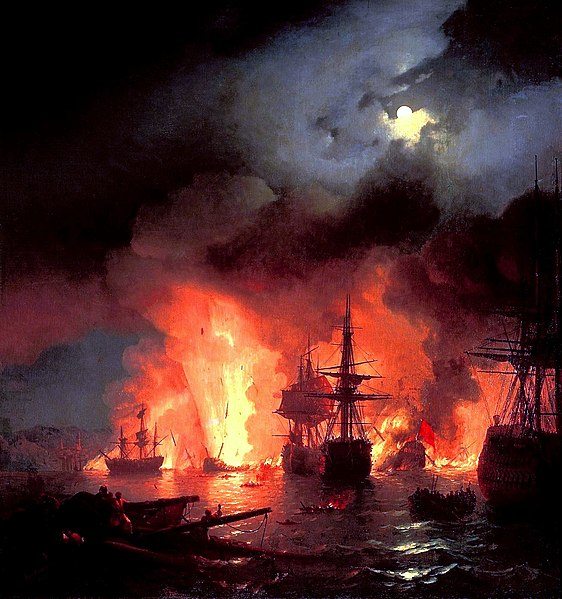
Ivan Aivazovsky painted a scene from the Battle of Cesme at Night. It shows a naval combat between the Russian and Ottoman empires that occurred in 1770 near the port of Cesme, in modern-day Turkey.
It is widely agreed that this is Aivazovsky’s most well-known seascape or marine picture. The painting’s dramatic lighting and color palette capture the ferocity and intensity of the combat.
The Aivazovsky National Art Gallery in Feodosia, Crimea is the current home of this piece.
5. The Battle of Trafalgar – J. M. W. Turner
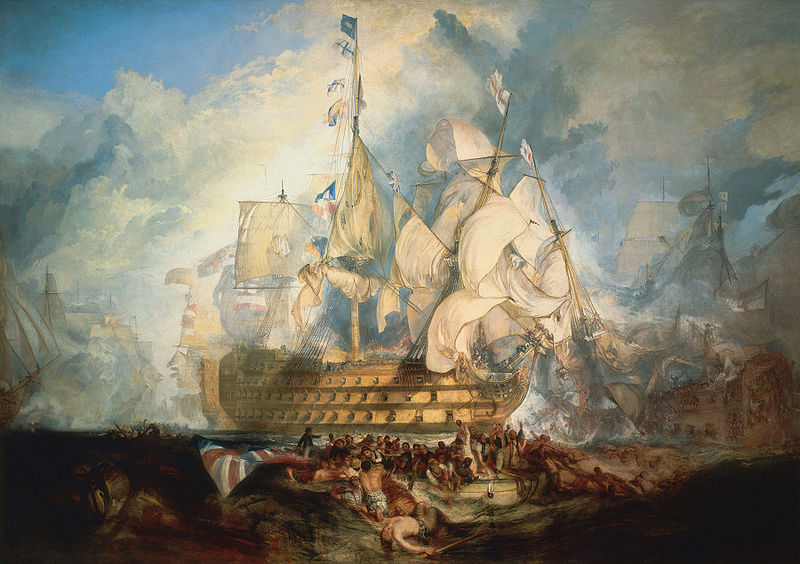
The Battle of Trafalgar, 21 October 1805, by British artist J. M. W. Turner, 1822. King George IV commissioned these paintings to decorate three state reception halls at St. James’s Palace and to honor the military successes of the Hanoverian kingdom.
Philippe-Jacques de Loutherbourg commissioned Turner to create this work as a companion piece to Lord Howe’s action on the Glorious First of June.
With dimensions of 2,615 mm (8 ft 6 + 15/16 in) by 3,685 mm (12 ft 1 + 1/16 in), this is his greatest work to date.
It was donated to Greenwich Hospital not long after its initial installation. They gave it to the National Maritime Museum in Greenwich, London.
6. The Battle of the Kearsarge and the Alabama – Édouard Manet
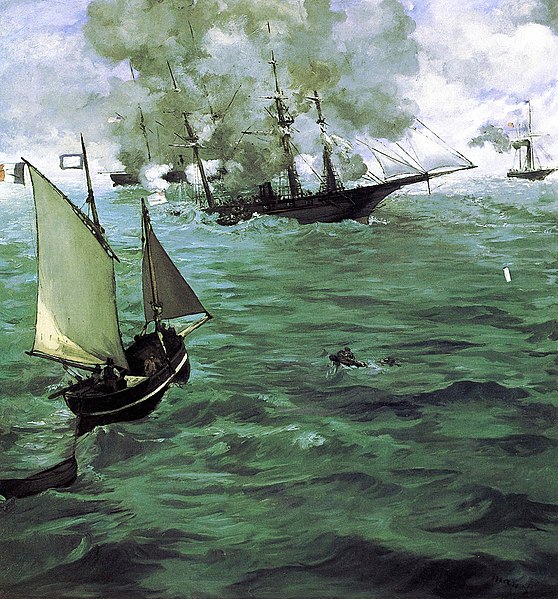
The Kearsarge and the Alabama in Action by Édouard Manet was completed in 1864. This picture is a memorial to the 1864 naval battle between the Union cruiser USS Kearsarge and the Confederate raider CSS Alabama during the American Civil War.
From the French coast, a large number of onlookers observed the USS Kearsarge successfully sink the CSS Alabama. Manet documented the battle based on press accounts because he was not present during the event.
Manet finished this picture and hung it in Alfred Cadart’s print shop in Paris less than a month after the war.
Art collector Marguerite Charpentier of France purchased the picture in 1878; it is presently on display at the Philadelphia Museum of Art.
7. The Battle of Alexander at Issus – Albrecht Altdorfer
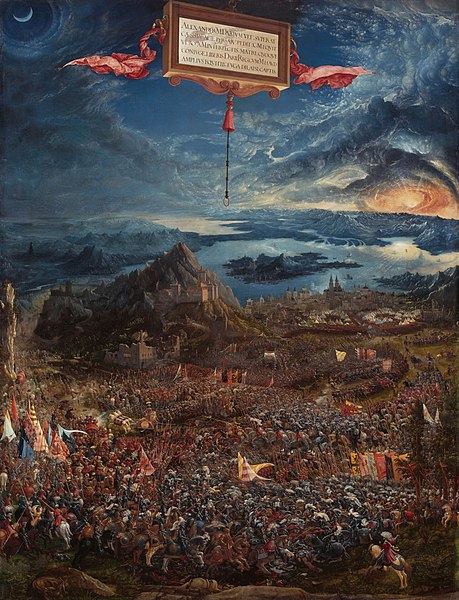
Albrecht Altdorfer (c. 1480-1538), a pioneer of landscape art and a founding member of the Danube school, painted The Battle of Alexander at Issus (German: Alexanderschlacht) in 1529.
The artwork depicts the decisive victory of Alexander the Great against Darius III of Persia at the Battle of Issus in 333 BC, which gave him a major tactical advantage in his war against the Persian Empire.
As one of the most well-known instances of Renaissance landscape painting, specifically the world landscape, which reaches unprecedented grandeur in this work, it is generally agreed that Altdorfer’s painting is his magnum opus.
The Battle of Alexander at Issus was commissioned in 1528 by Duke William IV of Bavaria for his palace in Munich.
8. The Death of Major Peirson – John Singleton Copley
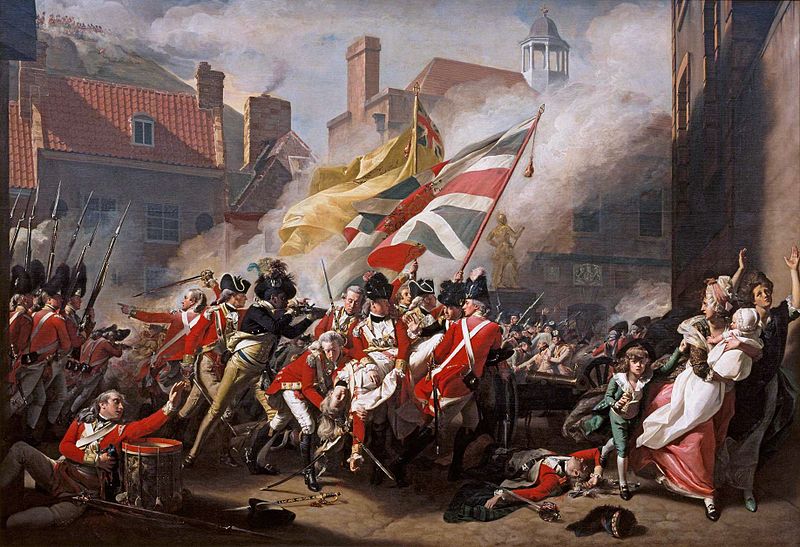
Another well-known artwork depicting a combat depicts the fatal wounding or death of a significant leader, this time from inside the ranks of the British. The Death of Major Peirson was the title given to this painting that was completed by John Singleton Copley in 1783.
In January of 1781, the actual incident took place when American-allied French soldiers invaded Jersey, only to be driven out by British forces led by the young Major Francis Peirson. The British forces were successful in their defense of Jersey.
The battle that took place in the streets of Jersey is depicted in great detail in the picture, which also shows women and children fleeing for safety on the outside of the city. The battle took place in Jersey.
9. The Death of General Wolfe – Benjamin West
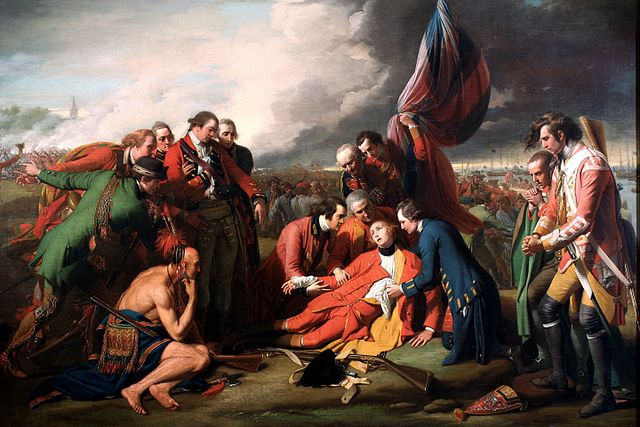
The conflict known as the Seven Years’ War was a deadly and arduous conflict that took place between the French and the British for dominion over what were then the colonies that were possessed by France. It lasted for a total of seven years.
The Battle of Quebec, which took place in 1759, is considered to be one of the most significant conflicts that took place during the war. The Battle of Quebec was a fierce conflict that ended with the death of British General James Wolfe, despite the fact that it was over in less than a quarter of an hour.
Benjamin West, an American painter, created a piece of artwork called “Death of General Wolfe” to honor the conflict. This painting, which was completed in 1770, is considered to be one of the most famous works from the Neoclassical period; yet, it is also one of the few works from that era that is historically erroneous in some of the most significant elements of the events that actually took place.
The artwork shows Wolfe passing away in the arms of his officers, although in actuality, he was murdered quickly by a shower of bullets from the French soldiers. The painting depicts Wolfe dying in the arms of his officers.
10. Napoleon Crossing the Alps – Jacques-Louis David
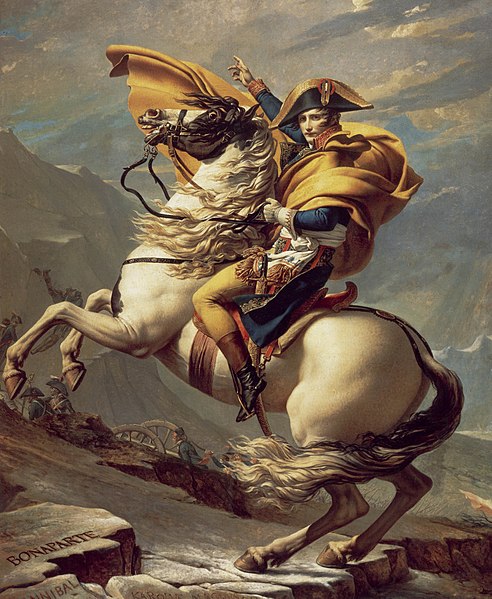
Because he painted so many portraits of influential people in politics and the arts, Jacques-Louis David is considered to be one of the most well-known artists of the Neoclassical period.
David began painting scenes of Napoleonic conflicts in 1801, and since then, those paintings have become instantly recognizable. The works paid homage to Napoleon’s legendary march overland across the Alps, which is widely regarded as one of the most treacherous mountain ranges in the world.
The commander was able to provide his troops with additional support in Italy by guiding them via tight tunnels that wound their way around the mountain peaks that were covered in snow.
David was given the task of creating a few works to commemorate what was, at the time, one of the boldest and most astute military strategies in recent memory.

